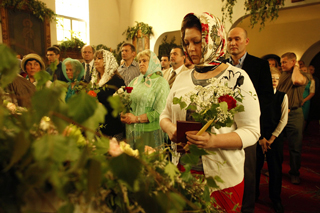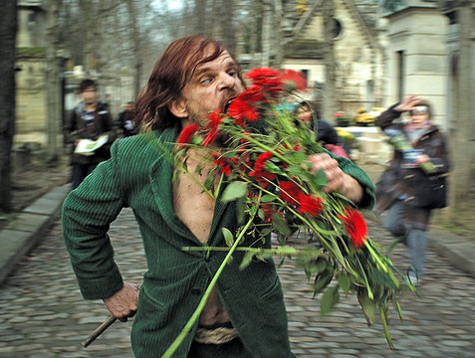Human Flower Project
Culture & Society
Wednesday, June 06, 2012
Birches at Pentecost
In the Orthodox Church, Holy Trinity (50 days after Easter) is draped with the greenery of birch boughs.

Pentecost 2012, at Saint Nicholas Russian Orthodox Cathedral, Seattle, Washington: the church is decorated with birch branches and flowers in observance of the Holy Spirit’s presence.
Photo: Erika Schultz/Seattle Times
In the Protestant denomination of our raising – the Episcopal Church – Pentecost meant an outpouring of red Sunday outfits and searing reference to the apostles’ “tongues of fire.” In the Eastern Orthodox faith, Pentecost – better known as Trinity Sunday – is green.
The Orthodox clergy wear green vestments shot through with golden threads, and churches are generously festooned with boughs of birch. Clusters of the spring leaves, heart shaped and serrated, stand in windows, adorn pulpits, and surround icons. In some parishes, stems of birch are scattered over the church floors, too. It’s as if the Holy Spirit descended not as fire but wind, shredding the trees outside and gusting them into the nave.
Saturday, May 26, 2012
Her Honor for a Potato Crop
Should a community garden director be free to hawk her Olympic torch?

Route of the Olympic Torch, May 26, 2012
Image: London Olympics 2012
Sarah Milner Simonds was honored by the Olympic committee to carry the Olympic torch along part of its route to the 2012 summer games. Simonds, a 38-year-old horticulturist, was chosen for her work with People’s Plot, “a community allotment in South Acton [West of London], where we can grow our own fruit and vegetables, cook and eat the food we grow together.”
But before Simonds ever trotted her segment of the Olympic relay, her honor was besmirched: she had tried to sell her torch on ebay.
According to the New York Times, the winning bidder offered 153,100 pounds, ($242,323) last Sunday, meanwhile drawing down the fury many observers – though the unnamed buyer has yet to pay up.
Simonds defended her position, saying she intended to plow all proceeds from the sale back into People’s Plot: “There are still lots of people who feel strongly that these iconic torches are somehow sacred and that trading demeans their value,” Simonds said. “To these I would ask how exactly can we plant our potatoes using a torch? They obviously didn’t understand my motives.”
Several other torchbearers likewise have tried or are now trying to sell their Olympic flame-carriers, and most of them too have designated specific charities as beneficiaries.
Are honorifics transferable commodities? There are plenty of Olympic medals up for sale on ebay right now. Does it matter that Simonds didn’t win her torch, rather that it was conferred upon her by the Olympic committee? Since she didn’t have to toss a shot put farthest or run fastest for it, does that make the object any less hers to do with as she pleases, or more so? Do her charitable motives make a difference?
The American Academy of Motion Pictures Sciences confronted the problem back in 1950, after a trade in Oscars has begun. In 1950 the Academy began binding winners to an agreement banning them or their heirs “from selling their Oscars to anyone but the Academy for the nominal sum of $1.”
Academy Awards made prior to 1950 are exempt. Michael Jackson bought the 1939 Best Picture Oscar, awarded to “Gone with the Wind,” for $1.54 million in 1999. Other less renowned statuettes, all awarded pre-1950, have sold at auction too.
Friday, May 25, 2012
Monsieur Oscar’s Fast Food
From “Please, Don’t Eat the Daisies” to “Holy Motors,” devouring flowers takes on a sinister new flavor.
A wild image of French actor Denis Lavant is making the rounds this week. Have you seen it? Eyes crossed and bare chest exposed beneath his jacket, he is running down the street chomping a bundle of red daisies.
Lavant portrays an ogre known mysteriously (and wittily) as Monsieur Oscar in Holy Motors, a new film by Leos Carax that just screened to applause and boos at the Cannes Film Festival.
One critic explains, “Mr. Oscar advances through his list of jobs – an old beggar woman, an assassin, a businessman, a father, a dying old man, a deranged, violent monster who eats flowers and kidnaps supermodels.”
In this age of downsizing, Mr. O demonstrates admirable resilience and quite a lot of energy, a far more entrepreneurial route than our own jagged career path. The list of unremunerated occupations lengthens, but “assassin” presumably still pays well.

Denis Lavant as Monsieur Oscar in Holy Motors
Photo: Cannes Film Festival/European Pressphoto Agency
Saturday, May 05, 2012
Araceli’s Flowers on a Seat of Honor
The patron saint of Lucena inspires a distinctive floral outpouring from the faithful of Southern Spain.

The Virgin of Araceli, patroness of Lucena, Spain, dressed in typical Andalusian costume
Photo: Oracion Año Jubilar
On the first weekend in May, residents of Lucena, Spain, make splendid veneration of their town’s patron saint the Virgin of Araceli.
This year the celebration promises to be especially lavish and well attended as it marks a “jubilee,” 450 years since the sacred statue came to Lucena from Rome. The town stretches out its season of celebration from April 30 forward (May is the traditional month of Mary), though Saturday May 5 is climactic: the major procession, will involve the formal offerings of flowers to Our Lady, as the statue moves from a shrine on the outskirts of town through the city to the church downtown.
“As usual, the procession will depart from Paseo de Rojas, and conclude in the Parish of San Mateo, which is home to the Lady of Lucena.

